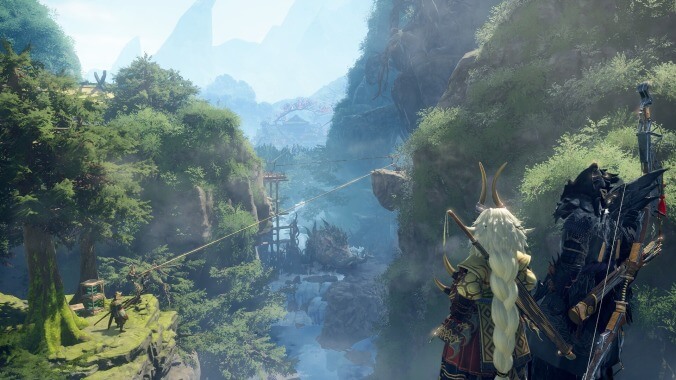Wild Hearts manages to make something fresh and exciting out of pilfered parts
From the creators of the Dynasty Warriors games, Wild Hearts liberally lifts the structure of Capcom's Monster Hunter for some acrobatic, dynamic combat

Every Friday, A.V. Club staffers kick off our weekly open thread for the discussion of gaming plans and recent gaming glories, but of course, the real action is down in the comments, where we invite you to answer our eternal question: What Are You Playing This Weekend?
I end up writing a lot in this space about remakes, remasterings, reimaginings, retreads, reinventions, etc. (Including remakes of RE games; whoo, synergy!) Partly that’s because there’s very little new under the sun. And partly it’s because modern gaming, with its prohibitively high production costs, naturally favors a conservative, “Do that thing that’s worked before” mindset.
But it’s also because gaming, more than most other artistic mediums, is an iterative one. It’s how play works: You try something, you feel out which parts work, and then you try again with meaningful tweaks. (This is, after all, the only major artistic medium where the end product is likely to change from week to week, courtesy of patches and updates.) And that’s something I’ve been thinking about a lot as I dip into Wild Hearts, Koei Tecmo’s recent attempt to “re-etc” Capcom’s long-running Monster Hunter franchise for its own purposes.
It took Monster Hunter a good long while to reach the point where anyone was even interested in stealing ideas from it, despite amazing contributions from artists, designers, and ground-breaking conductor-composers. Sure, we got the free-to-play Dauntless a few years back, and Bandai Namco’s God Eater franchise (before it transitioned into ripping off Dark Souls instead, via anime vampire nonsense Code Vein). But Wild Hearts is the first game I can think of that doesn’t just ape Monster Hunter, but which tries to—true to the series’ own ethos—cut its “beat up the giant monsters over and over to make cool pants” approach into parts and use them make something interesting and cool and new from them.
In its efforts to do so, Wild Hearts has two big points of appeal, which gel nicely together. The first is that it’s produced by Omega Force, the Koei Tecmo studio behind the Dynasty Warriors games—big, beautiful action rampages that live or die entirely on how good they can make swinging a gigantic sword or spear around feel in the players’ hands. In this case, that’s “pretty good”; after about 10 hours with Wild Hearts, I’ve found myself gravitating to a bladed umbrella weapon that sends me zipping all over the battlefield, parrying attacks from giant monsters, flying high into the air, and pile-driving down onto the head of a giant mutated boar like some kind of murderous, highly acrobatic Mary Poppins. (Other early weapons include a massive hammer that relies on rhythm-based inputs, and a giant Japanese sword capable of delivering some absolutely hellacious hits.) The Monster Hunter games have combat that can reach a pace and precision that’s thrilling, too, once you’ve attained a certain level of mastery. But Wild Hearts simplifies the button-presses and maximizes the on-screen fireworks to make you feel like a talented ass-kicker from the start.
The other fascinating bit—and the biggest selling point of the game, honestly, despite those cool-looking beasties—is the “karakuri” system, which allows you to build various devices on the fly to help you take down your prey. It would be reductive to call this insta-box-building system Fortnite-meets-Monster-Hunter … but not entirely inaccurate, as you quickly construct barricades to block charges, set up springs to allow you to dodge away from attacks, and deploy gliders to give you some air for another aerial strike. (You can also build more permanent structures that convey a ton of bonuses, including zip lines to make traversing the games’ lush levels easier.) It’s hard to express how good this system feels: Luring a rampaging Kingtusk into slamming its head into a barrier that wasn’t there two seconds earlier is deeply satisfying, and the build controls are remarkably intuitive. It’s clear that the designers want you to both have fun and feel powerful as you take control of the battlefield; it also feels genuinely fresh, an idea that is wholly the game’s own, despite all the imitation in its DNA. It feels like someone sat down and tried to imagine what you’d actually want on your side when beating up giant monsters, and then built the entire game around providing it.
Wild Hearts ain’t perfect; the camera, for instance, isn’t wholly on board with the difficulties of navigating around creatures that are sometimes 50 times the size of your player. (I have spent an uncomfortable chunk of the game’s early going with my view lodged firmly in the hollow insides of one of those aforementioned giant pigs.) And if the grind-based gameplay of its donor franchise doesn’t appeal to you, nothing here is going to change that. But, in much the same way that Capcom’s own recent Monster Hunter Rise attempted to redefine the gameplay of that series, Wild Hearts reminds me that there’s nothing inherently wrong with a bit of copying—as long as you’re doing something smart with your stolen goods.